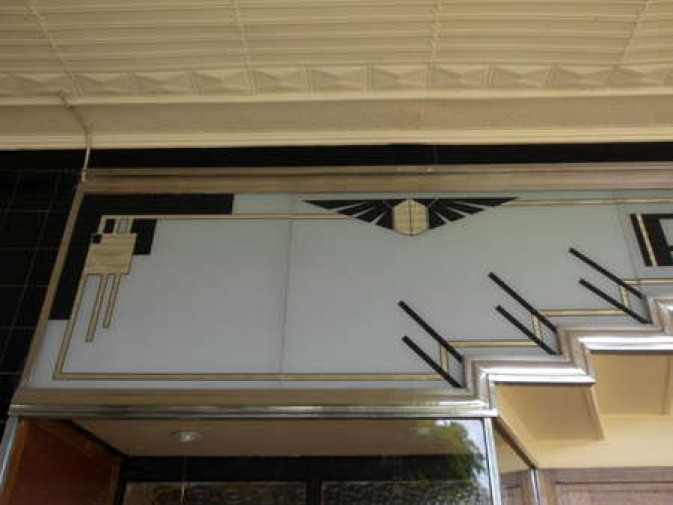A second example of Art deco design features framing the sign above the Roxy Cafe
From WIKI The structure of Art Deco is based on mathematical geometric shapes. It was widely considered to be an eclectic form of elegant and stylish modernism, being influenced by a variety of sources. The ability to travel and archaeological excavations during the first decades of the twentieth century, influenced artists and designers, integrating several elements from countries not their own. Among them were historical styles such as Greco-Roman Classicism, as well as the art of Babylon, Assyria, Ancient Egypt, Aztec Mexico, and Africa.
Much of this could be attributed to the popular interest in archaeology during the 1920s (e.g., the tomb of Tutankhamun, Pompeii, Troy, etc.). Art Deco also used Machine Age and streamline technologies such as modern aviation, electric lighting, radio, ocean liners and skyscrapers for inspiration. Streamline Moderne was the final interwar-period development, which most thoroughly manifests technology and has been rated by some commentators as a separate architectural style.
Art-deco design influences were expressed in the crystalline and faceted forms of decorative Cubism and Futurism. Other popular themes of Art Deco were trapezoidal, zigzagged, geometric, and jumbled shapes, which can be seen in many early works.
The Peters and Co, Roxy Cafe, Bingara sign, features exquisitely designed geometric art work in the Art Deco style
Restoration of the Roxy Cafe signage
It was to be restored glass paneling returning to grace the windows of the Roxy Cafe, but as the old glass was beyond restoration, the windows of the Roxy (Peters) Café now have a faithful reproduction of the original glass.
The work was done by Harradence Glass Decorators, a project Michael Harrington and his team approached with relish. After ascertaining the original colours used, the team then set about making an exact replica of the glass etching.
The old glass has been put into metal frames, and will become part of the display on a wall in the Roxy Museum. The Etched Glass Conservation Project was carried out with major funding support by the NSW Government office of Environment and Heritage, and Gwydir Shire Council.
Download a .pdf copy of this page from the Bingara Advocate, here:
Bingara_November_30_03.pdf
Announcement of original signage grant, Bingara Advocate
On Tuesday 29th November $60,000 worth of etched glass signage was erected on the Roxy Cafe frontage at Bingara. There are only 3 other examples of this type of signage in New South Wales. That is why the Heritage Branch of the Department of Planning, NSW provided a $30,000 grant for this project. This funding was supplemented by a grant of $30,000 from Gwydir Shire Council.
Harradence Glass Decorators
Glass Merchants and Glaziers
Glass etching
82 May Street
St Peters 2044
Ph: 02 9517 1488
Email, Harredence
http://www.harradence.com.au/
